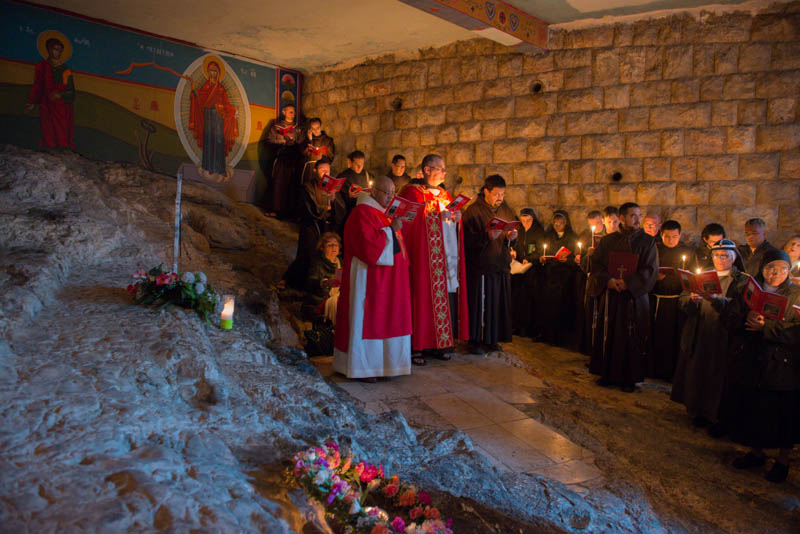
The day after Christmas is the celebration of St. Stephen, the first deacon and first martyr in the history of the Church. This December 26 as every year, the Franciscans of the Custody of the Holy Land celebrated the event in the Orthodox monastery situated in front of Gethsemane and the tomb of the Virgin Mary in the Kidron Valley. It is here that the "martyr" would have been stoned a few years after the death of Christ. One hundred followers, including many monks and nuns gathered in the cave and they could distinguish with the light of the candles, the murals depicting the stoning of St. Stephen, as well as the prayer of Jesus or even his arrest in the Mount of Olives.
The vespers were celebrated by Father Stéphane, guardian of the Custody of the Holy Land - of which Stephen is the patron saint of course- ... This is the first year of vespers’ celebration, usually this prayer does not take the form of a liturgy but of a simple pilgrimage in the footsteps of the martyr. The faithful sang several Christmas songs, continuing to enjoy the birth of Christ at this time of the year. They heard the reading taken from the Acts of the Apostles which recounts the stoning of St. Stephen. Saul, before he converted and became Paul, was present and appeared to endorse the murder.
Then Father Stéphane pronounced a few words about the importance of this martyr in the nascent Church. "Stephen was a key pillar for the early Christians, according to the Franciscan. He was a charismatic man that the disciples were ready to follow after Jesus' death. They were shocked when he was stoned". Father Stephane is certain that this shock is the responsible for the spread of Christianity in the world: "After the stoning of Stephen the disciples were frightened, so they fled Jerusalem and spread the Gospel in Asia, Cyprus, Africa ... without this first martyr, the Church would undoubtedly be very different today.”
For their part, the Orthodox only celebrate Stephen in January, as their liturgical calendar differs from that of Catholics. The Greek Orthodox priest in charge of the convent, Father Epifanios, sees in St. Stephen a model that should inspire every Christian: "We should be ready to die for Jesus if such situation arose. Do not be afraid, for He will welcome us to be close to Him. "The reading of the Acts of the Apostles has reminded the faithful that before his death, Stephen gave a speech very similar to that of Jesus at the moment of His own affliction, "Do not hold this sin against them.”
If this Orthodox monastery is the site of the death of St. Stephen, the martyr is not buried. His body was found in Cafargamala in the year 415, and his relics were transported by Bishop John of Jerusalem on December 26 of that year to the Church of Mount Zion in Jerusalem. They were transported later by the Empress Eudoxia to a church near the current Dominican monastery, close to the Damascus gate. Since then they have been lost.
After vespers, the faithful were able to enjoy a hot chocolate at the convent of Gethsemane.
Mélinée Le Priol
The vespers were celebrated by Father Stéphane, guardian of the Custody of the Holy Land - of which Stephen is the patron saint of course- ... This is the first year of vespers’ celebration, usually this prayer does not take the form of a liturgy but of a simple pilgrimage in the footsteps of the martyr. The faithful sang several Christmas songs, continuing to enjoy the birth of Christ at this time of the year. They heard the reading taken from the Acts of the Apostles which recounts the stoning of St. Stephen. Saul, before he converted and became Paul, was present and appeared to endorse the murder.
Then Father Stéphane pronounced a few words about the importance of this martyr in the nascent Church. "Stephen was a key pillar for the early Christians, according to the Franciscan. He was a charismatic man that the disciples were ready to follow after Jesus' death. They were shocked when he was stoned". Father Stephane is certain that this shock is the responsible for the spread of Christianity in the world: "After the stoning of Stephen the disciples were frightened, so they fled Jerusalem and spread the Gospel in Asia, Cyprus, Africa ... without this first martyr, the Church would undoubtedly be very different today.”
For their part, the Orthodox only celebrate Stephen in January, as their liturgical calendar differs from that of Catholics. The Greek Orthodox priest in charge of the convent, Father Epifanios, sees in St. Stephen a model that should inspire every Christian: "We should be ready to die for Jesus if such situation arose. Do not be afraid, for He will welcome us to be close to Him. "The reading of the Acts of the Apostles has reminded the faithful that before his death, Stephen gave a speech very similar to that of Jesus at the moment of His own affliction, "Do not hold this sin against them.”
If this Orthodox monastery is the site of the death of St. Stephen, the martyr is not buried. His body was found in Cafargamala in the year 415, and his relics were transported by Bishop John of Jerusalem on December 26 of that year to the Church of Mount Zion in Jerusalem. They were transported later by the Empress Eudoxia to a church near the current Dominican monastery, close to the Damascus gate. Since then they have been lost.
After vespers, the faithful were able to enjoy a hot chocolate at the convent of Gethsemane.
Mélinée Le Priol

